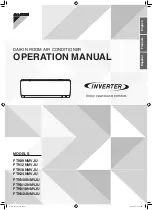
23
TCH032
E6
E7
Check code
Abnormal point and detection method
Cause
Countermeasure
Fb
E1
or
E2
1
Contact failure, short circuit or,
miswiring (converse wiring) of
indoor/outdoor unit connecting
wire
2
Defective transmitting receiving
circuit of indoor controller board
3
Defective transmitting receiving
circuit of indoor controller board
4
Noise has entered into indoor/
outdoor unit connecting wire.
Check LED display on the outdoor control
circuit board. (Connect A-control service
tool, PAC-SK52ST.)
Refer to the outdoor unit service manual.
1
Check disconnection or looseness of indoor/
outdoor unit connecting wire of indoor unit or
outdoor unit.
Check all the units in case of twin triple
indoor unit system.
2
–
4
Turn the power off, and on again to
check. If abnormality generates again,
replace indoor controller board or outdoor
controller circuit board.
Note:
Other indoor controller board may have defect
in the case of twin triple indoor unit system.
Indoor/outdoor unit communication
error (Transmitting error)
Abnormal if “1” receiving is detected 30
times continuously though indoor controller
board has transmitted “0”.
1
Defective transmitting receiving
circuit of indoor controller board
2
Noise has entered into power
supply.
3
Noise has entered into outdoor
control wire.
1
–
3
Turn the power off, and on again to
check. If abnormality generates again,
replace indoor controller board.
Indoor/outdoor unit communication
error (Signal receiving error)
1
Abnormal if indoor controller board
cannot receive any signal normally for 6
minutes after turning the power on.
2
Abnormal if indoor controller board
cannot receive any signal normally for 3
minutes.
3
Consider the unit abnormal under the
following condition: When 2 or more
indoor units are connected to an outdoor
unit, indoor controller board cannot
receive a signal for 3 minutes from
outdoor controller circuit board, a signal
which allows outdoor controller circuit
board to transmit signals.
Indoor controller board
Abnormal if data cannot be read normally
from the nonvolatile memory of the indoor
controller board.
1
Defective indoor controller
board
1
Replace indoor controller board.
Remote controller control board
1
Abnormal if data cannot be read nor-
mally from the nonvolatile memory of the
remote controller control board.
(Check code: E1)
2
Abnormal if the clock function of remote
controller cannot be operated normally.
(Check code: E2)
1
Defective remote controller
1
Replace remote controller.
E3
or
E5
Remote controller transmission error(E3)/
signal receiving error(E5)
1
Abnormal if remote controller could not
find blank of transmission path for 6
seconds and could not transmit.
(Check code: E3)
2
Remote controller receives transmitted
data at the same time and compares the
received and transmitted data. Abnormal
if these data are judged to be different
30 continuous times. (Check code: E3)
1
Abnormal if indoor controller board could
not find blank of transmission path.
(Check code: E5)
2
Indoor controller board receives
transmitted data at the same time and
compares the received and transmitted
data. Abnormal if these data are judged
to be different 30 continuous times.
(Check code: E5)
1
Set a remote controller to main, and the
other to sub.
2
Remote controller is connected with only one
indoor unit.
3
The address changes to a separate setting.
4
–
6
Diagnose remote controller.
a) When “RC OK” is displayed, remote con-
trollers have no problem.
Turn the power off, and on again to check.
When becoming abnormal again, replace
indoor controller board.
b) When “RC NG” is displayed, replace
remote controller.
c) When “RC E3” or “ERC 00-66” is dis-
played, noise may be causing abnormal-
ity.
1
2 remote controllers are set as
“main.”
(In case of 2 remote controllers)
2
Remote controller is connected
with 2 indoor units or more.
3
Repetition of refrigerant address
4
Defective transmitting receiving
circuit of remote controller
5
Defective transmitting receiving
circuit of indoor controller board
6
Noise has entered into
transmission wire of remote
controller.
















































